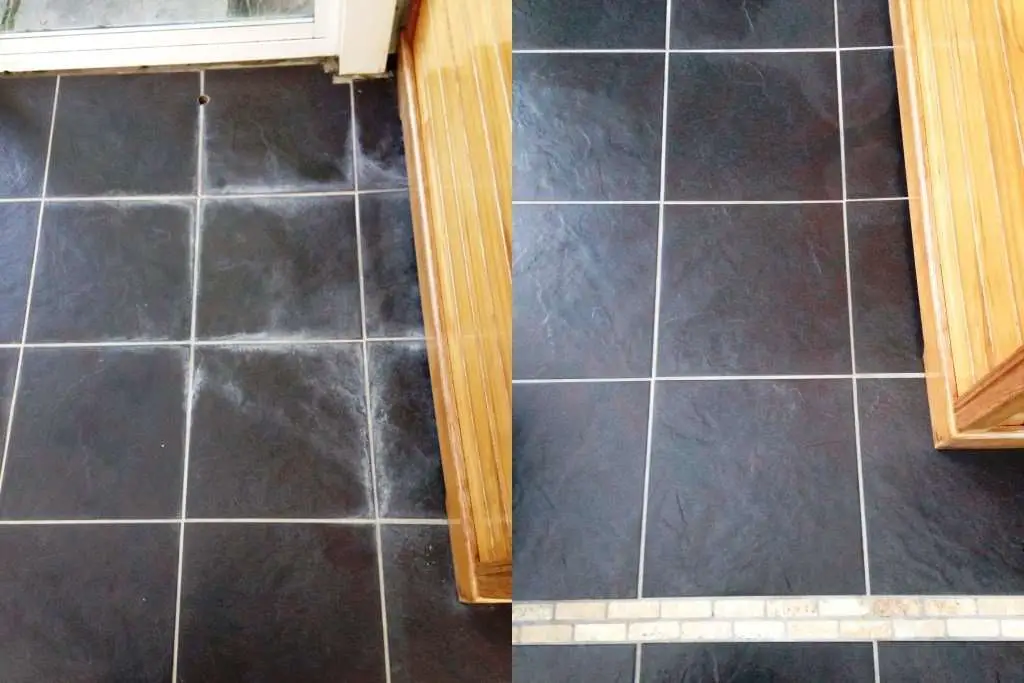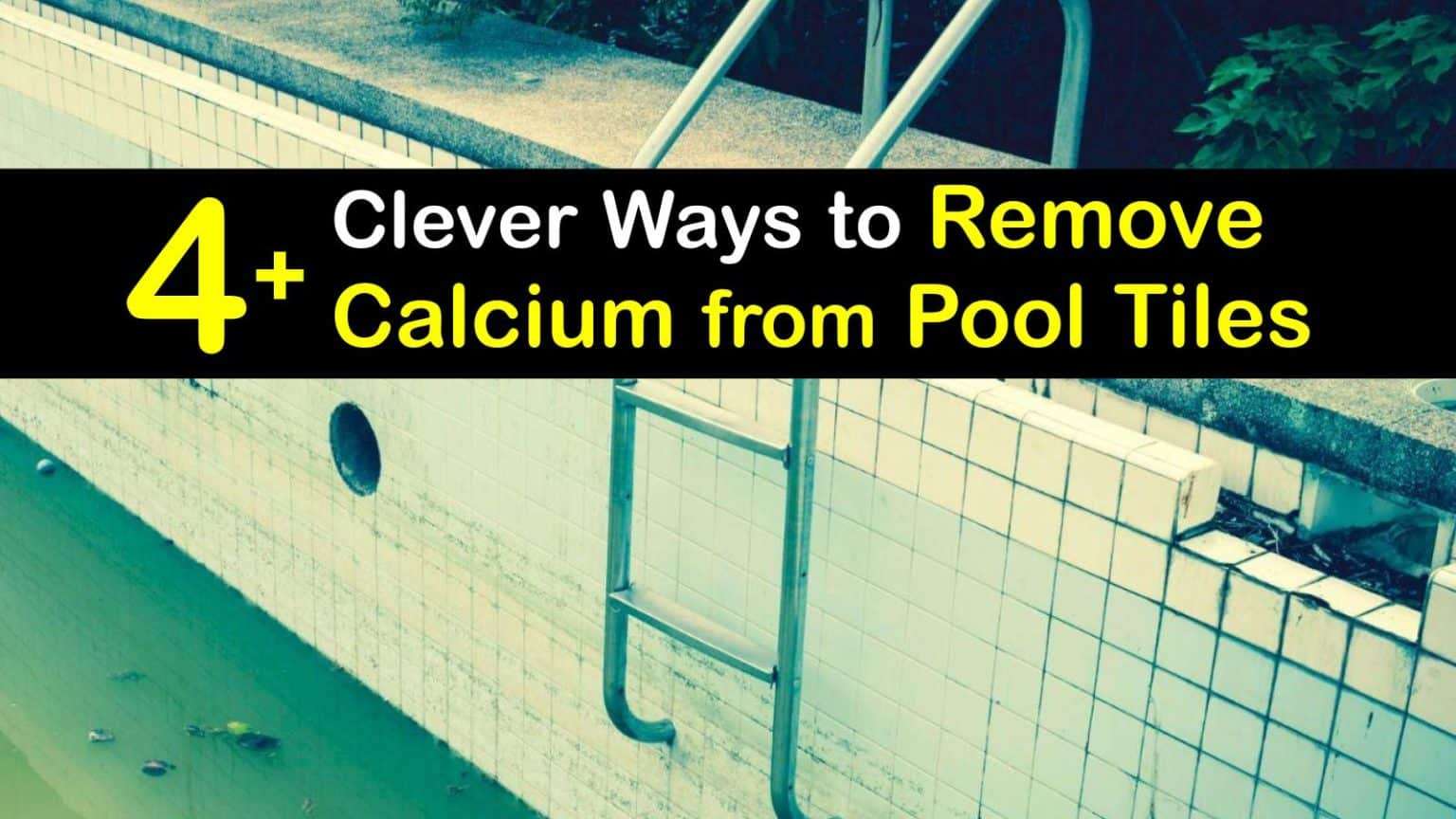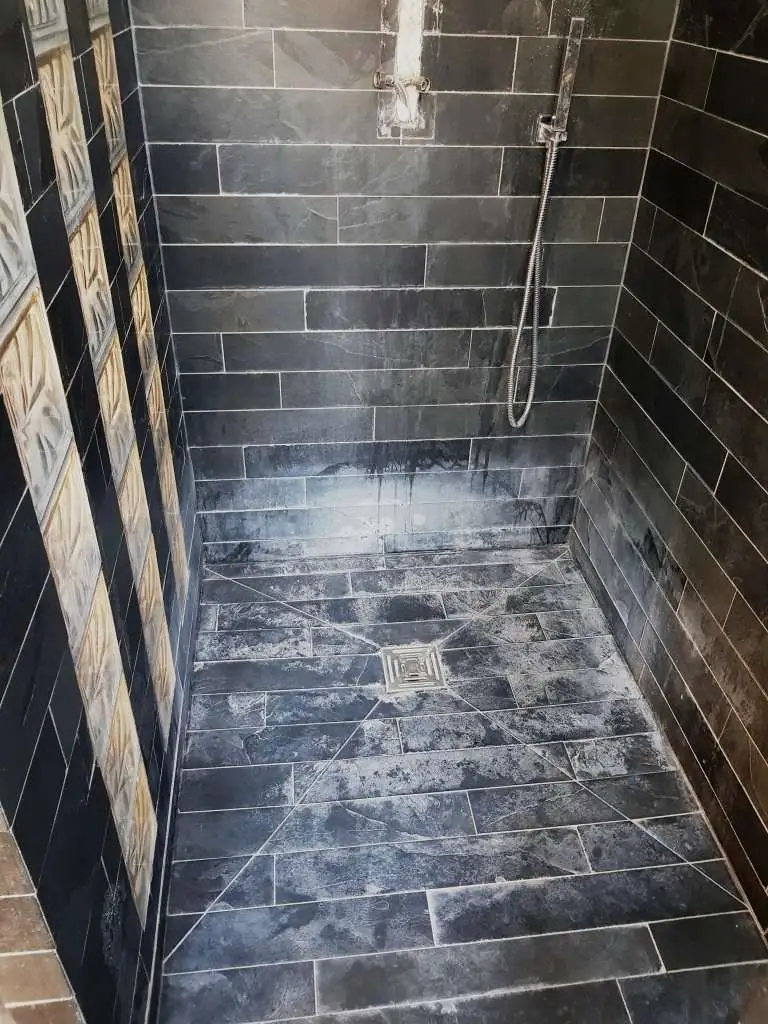Cleaning Pool Tiles Calcium Deposits With A Pressure Washer
A great addition to your pool service routine is a pressure washer, which uses intense force to spray water at a fast rate, breaking through calcium hardness that is often difficult to remove.
An alternative to pressure washing is bead blasting, which applies glass beads at high pressure and does not cause damage.
If you do not have a pressure washer in your garage, do not worry. Pressure washers are commonly found at your local home improvement store to rent.
Aim the nozzle at areas with calcium deposits and just above the water level to clear away deposits. Do not wash any tiles that are loose or cracked, as pressure washing may cause more damage.
Learning how to remove calcium deposits from swimming pool tiles is easier with a pressure washer.
Remove Hard Water Stains From Tile And Grout With Baking Soda
Baking soda is a cleaning tool that has diverse uses. Similar to when you clean a spa with vinegar, the ingredients in baking soda effortlessly dissolve grime, dirt, grout stains, and calcium deposits and is the fastest way to get rid of algae in a pool.
If you want to learn how to remove calcium deposits from swimming pool tiles, use a simple baking soda mixture. This baking soda cleaner will also remove calcium deposits on fiberglass.
- ½ cup of baking soda
- ¼ cup of hydrogen peroxide
- 1 teaspoon liquid dish soap
- ¼ cup of water
Combine the cleaning ingredients in a medium-sized mixing bowl and stir until the consistency is the same throughout. After putting on rubber gloves to protect your skin, apply the mix onto the affected areas with grout buildup and as the way to remove grout stains from tile.
Let the baking soda mixture sit for ten minutes to loosen up the grout stain before spraying it clean with a pressure washer or hose.
Can I Use Clr On Pool Tiles
Unfortunately, we do not recommend using CLR on pool tile. It could remove the finish from the tile. In addition, if CLR comes in contact with chlorine, it could result in toxic fumes. We recommend consulting with a pool maintenance expert for their recommendation for products that are safe and effective.
Read Also: What Are Pool Cages Made Of
Will Muriatic Acid Remove Calcium Deposits
Because muriatic acid is so much stronger than vinegar or the other cleaning agents mentioned above, it can remove calcium deposits that are much more advanced. That being said, with deposits that have been growing and hardening for a long time, sometimes not even muriatic acid is enough.
Safely Dispose Of Unused Acid

Contact your local pool supply business or municipality to learn how to dispose of any unused muriatic acid. Do not simply throw it away or pour it down a drain.
Because muriatic acid is so much stronger than vinegar or the other cleaning agents mentioned above, it can remove calcium deposits that are much more advanced. That being said, with deposits that have been growing and hardening for a long time, sometimes not even muriatic acid is enough.
If thats your situation, you have two remaining options: a;pumice stone and a lot of elbow grease, or pressure washing.
Since we already spent time on the intense nature of cleaning with muriatic acid, we will skip the pumice stone method to give you a break and talk about pressureor beadwashing.
Read Also: How To Increase Ph Level In Pool
Types Of Calcium That Leave Deposits
There are 2;common types of calcium;that form lime in a pool:;calcium carbonate;and;calcium;silicate.;It is important to understand;which type harms the walls of your pool.
The calcium carbonate;is white, scaly and easily detached.;Calcium silicate is slightly gray and more solid, which makes it more difficult to remove.
If;the walls of your pool contain calcium silicate, the scale on the walls of your pool is a symptom of a more serious problem:;calcium scale in the plumbing and filtration system.;This is a problem that only a professional;pool maintenance company can deal with.
If you dont know;what type you have on your pool, use a;dropper;to;pour muriatic acid on the deposits.;Calcium carbonate will foam in reaction to acids.;Calcium silicate, being a more solid substance with robust construction, will remain unchanged.
How Long Does It Take For Vinegar To Dissolve Calcium Deposits
The acetic acid in white vinegar acts as a solvent, which helps to dissolve the mineral deposits that are clogging up your showerhead. After soaking in vinegar for an hour or two, that build up should wash away the next time you turn your shower on.
Recommended Reading: Where To Buy Swimming Pools
What Causes Limescale Buildup
Before cleaning your pool surfaces free from calcium deposits, you need to understand what causes the white stains on your pool tile.
The most common cause of calcium buildup is from a high pH level or alkalinity, which causes calcium carbonate to separate from the pool water and leave an unwanted stain.
Another potential cause of limescale buildup is intense heat. High temperatures evaporate water quickly and are more likely to leave a calcium stain behind. Any pool surfaces that come in contact with water are at risk for calcium scaling.
How To Remove Calcium Scale
Calcium Scale can be removed with muriatic acid, or dry acid dissolved in water. A sponge works well for small areas or a flower watering can for larger areas. Don your lab glasses and gloves for acid removal of tile scale. It will fizz and bubble and emit noxious fumes as it dissolves the scale. Acid Magic or Instant Liquid Acid or even pH Decreaser can also be used as a safer acid to remove scale. Do not use CLR or household cleaners to remove pool scale however, which add chemicals that dont belong in your pool.
Photo Credit: PST Pool Supplies; Oceanside, Ca
For swimming pools, the range of acceptable hardness levels is 200-400 ppm, although many suggest a tighter range of 180-220 ppm for plaster pools and 150-250 ppm for vinyl pools.
Also Check: What Pool Chemicals Do I Need
Will Vinegar Clean Pool Tile
VinegarClean Pool TilesvinegarcleaningVinegarcleanpool
Calcium deposits from hard water are more difficult to remove and may take more elbow grease and a longer time to clean. Spray 100% vinegar on tile and let it sit for 5 minutes. Clean a few tiles at a time, rinse with pool water, evaluate, and continue. Repeat until all of the pool tiles are clean.
Secondly, what is the best way to remove calcium deposits from pool tile? Removing Calcium Carbonate ScalingIf your pool has calcium carbonate deposits, you can remove them with a pumice stone, stain eraser or scale remover. A pumice stone should only be used on hard surfaces, such as tile and concrete. Simply use the stone to scrub the deposits.
Consequently, can you use vinegar to clean a pool?
White VinegarMix a 50/50 solution of vinegar and water, dip a sponge or soft cloth into it, and scrub that residue away. It’s OK if a little bit of it makes it into the pool water, but if you‘re concerned, test the water after using vinegar, and adjust any levels if necessary.
How do you remove hard water stains from pool tile?
Fill a plastic spray bottle with the water and muriatic acid mixture. Make sure you label the spray bottle, or dispose of it properly. Spray the pool tiles with the muriatic acid mixture. Use a nonabrasive scouring pad to remove the hard water stains.
Why Calcium Is A Problem
Two types of calcium can cause problems with pools. Sometimes deposits consist of a fine film that builds up in layers, leaving behind a residue that easily comes off tiles if theyre cleaned regularly. This is called calcium carbonate. Sometimes buildup results in sharp, crystalized and sandy particles that attach to the tiles, caused by high calcium and pH levels in the water, and which requires more intensive cleaning methods. This is calcium silicate.
Learning how to remove calcium from pool tiles early can save both time and money. Often referred to as calcium scale, it gets worse the longer its left. Ignoring it will cause damage not only to pools, but to pool equipment as well. Regularly cleaning any scum lines usually presenting as white or light gray deposits will keep the buildup at bay and make pool tile scale removal easier. Sometimes it just involves cleaning the deposits with a soft cloth. Since this is easier done when in the pool, its a chore that can keep the cleaner cool on a hot day.
Also Check: How To Build Your Own Swimming Pool
Does Clr Remove Calcium From Pool Tile
Calcium Scale can be removed with muriatic acid, or dry acid dissolved in water. Acid Magic or Instant Liquid Acid or even pH Decreaser can also be used as a safer acid to remove scale. Do not use CLR or household cleaners to remove pool scale however, which add chemicals that dont belong in your pool.
How To Clean Pool Tile

Cleaning pool tile is easy and should be a regular part of any well-rounded pool maintenance routine. It will not only extend the life of your tile but also reduce the lifetime maintenance costs because you wont have to replace tile pieces as often. Most stains and buildup can be cleaned similarly.
Don’t Miss: How Hard Is It To Build Your Own Pool
S To Help Prevent Harsh Water Stains
The mineral makeup of the water usually causes the hard water stains in your pool and the elements of nature. Pool contractors will tell you that the harsh water stains largely depend on the quality of the water supplied in your area. However, there are specific steps you can take to reduce the occurrence of such hard water stains. Although it may not eliminate scaling, it will increase the time between two pool cleaning sessions.
- Reduce the pH of the water in the swimming pool to a slightly alkaline scale say 7.2 to 7.4. This change will create a relatively acidic condition which is not conducive to scaling.
- Add a regular sequestering agent to your weekly maintenance. This agent locks the calcium in the water in the liquid state so that it doesnt accumulate at the water line.
- Brushing your pool regularly to remove any calcium residue as it begins to form at the edges.
- Dont use any substance that adds calcium to the water, for example; calcium hypochlorite shock. Prefer using a non-chlorine oxidizer shock.
- Using a clarifier that eliminates any calcium particles in the pool.
If you have any doubts, contact our pool;experts for assistance. Wed love to help you keep your swimming pool neat, clean and free from stains!
What Causes Scale In A Pool
Calcium carbonate can happen due to evaporation during summer around your water line in the pool.
Calcium crystals will form as a nodule which dots the surface of your pool or metal surfaces and even cause crusty deposits in the corner of your pool.
This can happen due to high calcium hardness which is caused by high pH levels, high alkalinity, and high water temperatures.
Also Check: What Is The Best Pool Vacuum
How To Clean Pool Tile With Muriatic Acid
When we say muriatic acid is a more serious pool cleaning method, we mean it. The word acid indicates that this is more powerful than other types of solutions. You can find this chemical at a home improvement or pool supply store.
With vinegar and the other mild cleaners weve already mentioned, you can get into the pool while youre cleaning. With muriatic acid, however, this is absolutely not something to try.
Heres what you need to get started:
- container of muriatic acid
- nonabrasive scouring pad
This list of materials is enough to make you realize that this goes way beyond pool maintenance for beginners.
Gathering your materials is really just the beginning. Below well detail the steps. Before going forward, we just want to remind you that that muriatic acid is dangerous. You may decide to have a pool cleaning company handle your problem rather than risking possible injury.
Yes, its that serious.
If youve decided you would like to try this yourself, lets dive into the step-by-step instructions.
Controlling Calcium Hardness In Pools
As opposed to removing calcium in pools, many pool owners opt to control the mineral build-up in pools. The primary method of control is to keep well-balanced pH and alkalinity levels. With a proper pH of 7.2-7.4 and Total Alkalinity of 80-100 ppm, high levels of calcium rarely become problematic.
Secondly, using a sequestering agent like Scale Free or Stain Away, will lock-up minerals with a strong chemical bond, that will keep calcium from precipitating out of solution, to form scale or visibly cloud the water.
Avoiding use of calcium based sanitizers, such as Calcium Hypochlorite, is also recommended as a way to reduce calcium build-up. Lithium, Dichlor or non-chlorine shock can be used as alternative pool shocks, that wont add calcium to the pool.
Read Also: Can You Heat An Above Ground Pool
How Does Calcium Scale Get In Your Pool
Calcium scaling is usually caused by high calcium hardness levels, and triggered by high pH and high alkalinity. So it’s important to test the calcium hardness levels in your pool every time you test the other chemicals. You can either do this yourself with a pool test kit, or bring a water sample into a pool service store to do it for you.
But usually if this level is off, the pH level will also be off, as pH is actually the agent that affects calcium buildup the most.
The reason for this is that a high pH level will cause the calcium that is naturally in the pool water to solidify and deposit itself on pool surfaces. This is what we call scaling and it can be a pain to get off!
Calcium scale deposits can also be left behind by evaporating water. You’ll usually see this scaling right around the water line as well.
Two Types Of Calcium Buildup
There are two types of calcium scales that form in pools: calcium carbonate and calcium silicate. Calcium carbonate is white and flaky, and its fairly easy to take off. Calcium silicate, in contrast, is white-grey and more difficult to move.
Additionally, because calcium silicate takes longer to form, pools that have calcium silicate buildup on their walls often also have scaling in their pipes. If your pools scaling proves to be calcium silicate, you may need to hire a professional to remove the deposits in your pool and its filtration system.
To see what type of calcium scaling has built up on your pool, place a few drops of muriatic acid on a deposit. Calcium carbonate will react with the acid and foam; calcium silicate will not.
Also Check: How To Repair Cracks In Concrete Pool Deck
How To Remove Calcium Deposits From Swimming Pool Tiles
Often you can notice white and chalky calcium on your swimming tiles pool surfaces. The calcium hardness is not dangerous, but its residue affects the pools appearance. Calcium hardness causes various buildup types of stains, heat, and hard water. Yet, the calcium buildup is most usual, and there are two forms available.
The first build is a calcium carbonate that leaves residue layers on swimming pool tiles. If you clean the pool tile quite often, you will remove calcium easily. You should use acidic solutions to take care of calcium carbonate if it builds up. Another type of calcium buildup is calcium silicate from the sand. It produces crystallized and sharp buildup, which is caused by calcium levels and high pH.
Calcium requires intensive cleaning methods, and when they build up, they cause filter failure. So, you should remove calcium from the pool tile carefully because muriatic acid can cause enormous damage. The muriatic acid will remove calcium while leaving tiles in flawless condition.
Cleaning the swimming pool tile at the waterline is quite a dirty process. This waterline pool tiles cleaning process is not tricky, but it is a pretty long process. Now, lets take a closer look at some steps for cleaning calcium deposits from a pool tile.
What Are Harsh Water Stains

Water stains are the cloudy white deposits that occur on the water line of the pool usually as a result of hard water. Commonly referred to as scum, these calcium carbonates, and calcium silicate deposits accumulate around the area where the water meets the tiles. It is usually near the pools surface and occurs at around the markup to which the water in the pool generally reaches.
This mineral buildup that occurs in your pool varies depending on the quality of water in your area. Usually, the harder the water, the higher the calcium scaling will be. This buildup not only makes the water cloudy, but it also affects the pH of the water.
According to the Association of Pool & Spa Professionals, the ideal pH of the water should be between 7.4 and 7.6 to ensure a safe and healthy swimming experience.
Also Check: Do Babies Wear Diapers In The Pool
Removing Limescale From Porcelain Tiles
To remove the Limescale each stain was spot treated using Tile Doctor Grout Clean-up which is a strong acid based cleaning product normally used to remove grout smears from tiles but also equally useful at dealing with mineral deposits such as Limescale. You have to be very careful with acids on tiles, especially natural stone so once it had done its job the tiles were thoroughly rinsed and the whole floor rinsed again once we have completed everything.
When we had finished the client couldnt believe the transformation we have managed to achieve.
